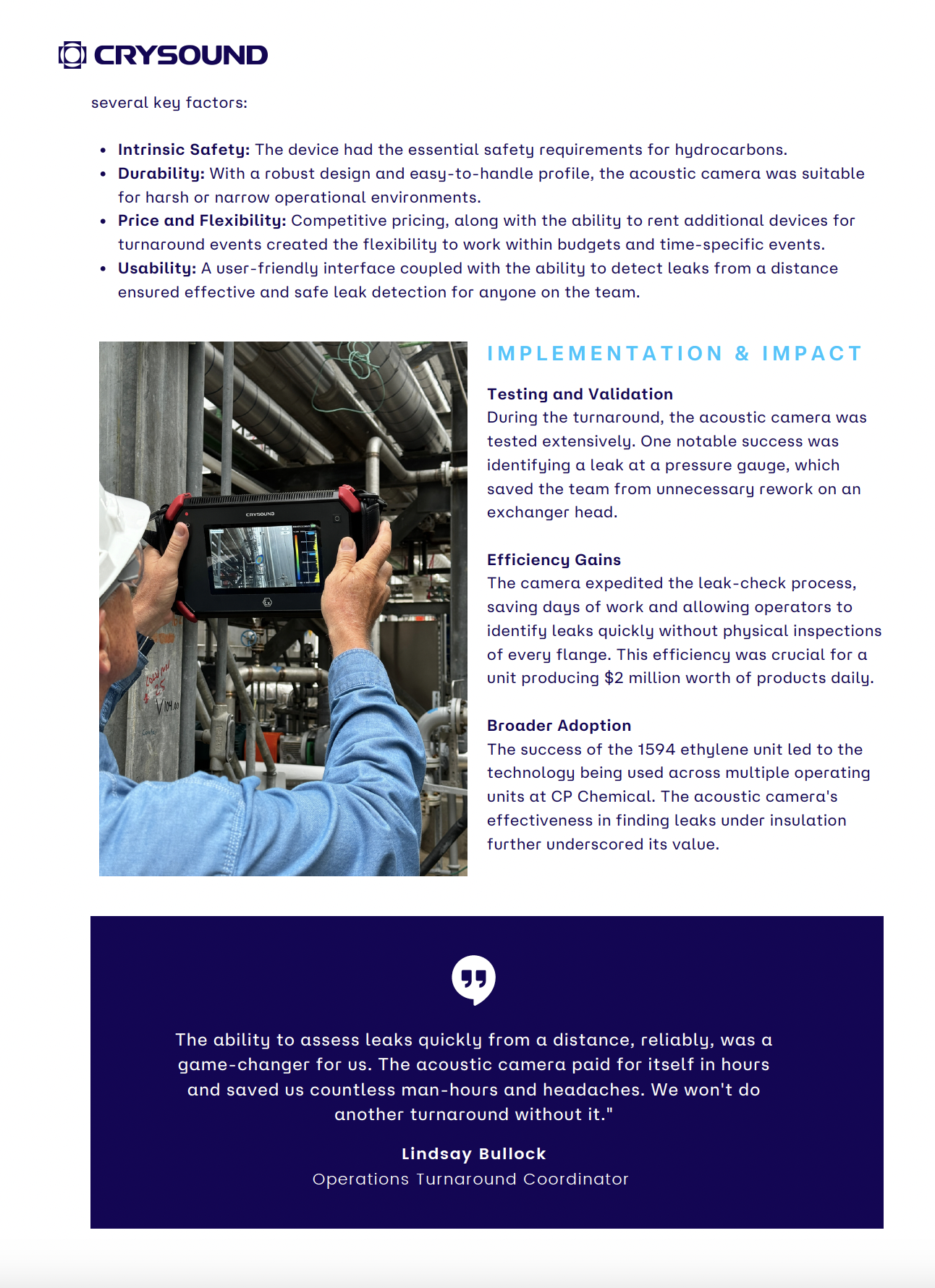Copywriting
CRYSOUND Case Study
How Chevron Phillips Chemical Used Acoustic Camera Technology to Boost Operations
Written for CRYSOUND, Inc.
About Chevron Phillips Chemical
Chevron Phillips Chemical (CP Chemical) is a global chemical manufacturing facility specializing in the production of ethylene and polyethylene derivatives. With multiple sites worldwide, the Cedar Bayou site employs over 3,000 people during peak operations.
The Challenge
CP Chemical faced significant challenges during the turnaround of their 1594 ethylene unit, a complex process requiring extensive coordination and safety measures. With over 1,500 blinds needing removal and reinstallation, traditional leak-checking methods proved impractical due to the sheer volume and complexity of the task.
Lindsay Bullock, an engineer with 20+ years of experience in the industry, led the decision-making process of finding a solution for faster leak detection. Along with her team, she initially considered thermal cameras for leak detection but found them unsuitable due to the high levels of steam that muddied the thermal background. They needed a more effective solution to handle the large bore piping and hydrocarbon services within their unit.
Customer Quote
The ability to assess leaks quickly from a distance, reliably, was a game-changer for us. The acoustic camera paid for itself in hours and saved us countless man-hours and headaches. We won't do another turnaround without it." – Lindsay Bullock, Operations Turnaround Coordinator
Discovering CRYSOUND
Through industry contacts, Lindsay and her team learned about CRYSOUND's acoustic camera technology. After comparing it with other devices in the market, they chose CRYSOUND's solution based on several key factors:
Intrinsic Safety: The device had the essential safety requirements for hydrocarbons.
Durability: With a robust design and easy-to-handle profile, the acoustic camera was suitable for harsh or narrow operational environments.
Price and Flexibility: Competitive pricing, along with the ability to rent additional devices for turnaround events created the flexibility to work within budgets and time-specific events.
Usability: A user-friendly interface coupled with the ability to detect leaks from a distance ensured effective and safe leak detection for anyone on the team.
Implementation & Impact
Testing and Validation: During the turnaround, the acoustic camera was tested extensively. One notable success was identifying a leak at a pressure gauge, which saved the team from unnecessary rework on an exchanger head.
Efficiency Gains: The camera expedited the leak-check process, saving days of work and allowing operators to identify leaks quickly without physical inspections of every flange. This efficiency was crucial for a unit producing $2 million worth of products daily.
Broader Adoption: The success of the 1594 ethylene unit led to the technology being used across multiple operating units at CP Chemical. The acoustic camera's effectiveness in finding leaks under insulation further underscored its value.
Results
Time Savings: The acoustic camera saved CP Chemical several days of leak-checking time, directly translating to significant financial savings and faster return-to-service for critical units.
Cost Savings: Avoiding unnecessary rework and efficiently managing leak detection helped CP Chemical save considerable amounts in labor and operational costs.
Improved Safety: Enhanced leak detection contributed to safer operations by ensuring leaks were identified and addressed promptly, reducing the risk of environmental and safety incidents
Conclusion
CRYSOUND's acoustic camera has become an indispensable tool for the Cedar Bayou site of Chevron Phillips Chemical. By proving its value in turnaround events and ongoing operations, Lindsay anticipates the technology will become industry best practice, highlighting its potential to revolutionize leak detection and management in the chemical manufacturing industry.
Highlights
ROI in hours | Durable design | User-friendly | Cost-effective
Above: Image of PDF version, page 1.
Above: Image of PDF version, page 2


